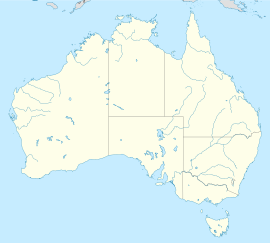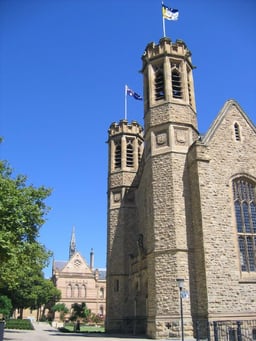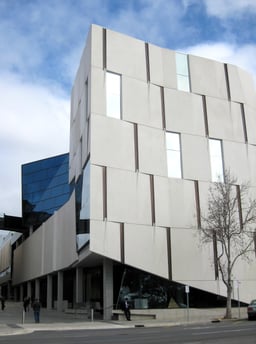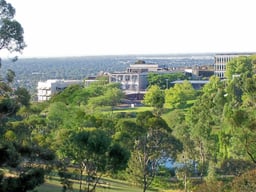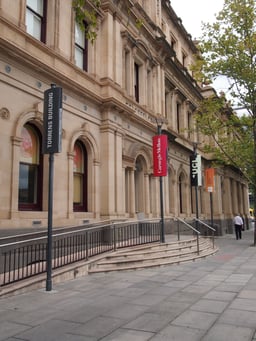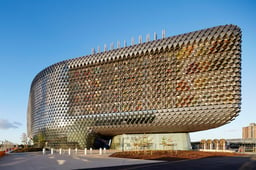Adelaide
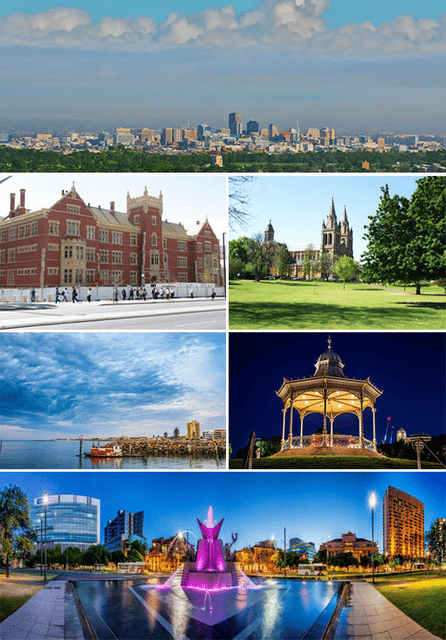
Adelaide

| Adelaide South Australia | |||||||||
|---|---|---|---|---|---|---|---|---|---|
| Coordinates | 34°55′44″S 138°36′4″E [182] | ||||||||
| Population | 1,345,777 (2018)[6] (5th) | ||||||||
| • Density | 413.106/km2(1,069.941/sq mi) (2011) | ||||||||
| Established | 28 December 1836 (1836-12-28) | ||||||||
| Area | 3,257.7 km2(1,257.8 sq mi)[7] | ||||||||
| Time zone | ACST (UTC+9:30) | ||||||||
| • Summer (DST) | ACDT (UTC+10:30) | ||||||||
| Location | |||||||||
| State electorate(s) | Adelaide | ||||||||
| |||||||||
| Country of Birth (2016)[90] | |||||||||
| Birthplace[1] | Population | ||||||||
| Australia | 884,250 | ||||||||
| England | 80,795 | ||||||||
| India | 26,270 | ||||||||
| Mainland China | 23,919 | ||||||||
| Italy | 17,398 | ||||||||
| Vietnam | 13,932 | ||||||||
| Philippines | 10,204 | ||||||||
| New Zealand | 9,882 | ||||||||
| Germany | 8,242 | ||||||||
| Greece | 8,022 | ||||||||
| Malaysia | 7,465 | ||||||||
| Afghanistan | 5,847 | ||||||||
| South Africa | 5,587 | ||||||||
Adelaide (/ˈædəleɪd/ (listen) AD-ə-layd)[13] is the capital city of the state of South Australia, and the fifth-most populous city of Australia. The demonym Adelaidean is used to denote the city and its residents.
Adelaide is situated on the Adelaide Plains north of the Fleurieu Peninsula, between the Gulf St Vincent in the west and the Mount Lofty Ranges in the east. Its metropolitan area extends 20 km (12 mi) from the coast to the foothills, and stretches 96 km (60 mi) from Gawler in the north to Sellicks Beach in the south.
Named in honour of Queen Adelaide, consort to King William IV, the city was founded in 1836 as the planned capital for the only freely-settled British province in Australia.[14] Colonel William Light, one of Adelaide's founding fathers, designed the city centre and chose its location close to the River Torrens, in the area originally inhabited by the Kaurna people and known as Tarndanyangga ("place of the red kangaroo"). Light's design, now listed as national heritage, set out the city centre in a grid layout, interspaced by wide boulevards and large public squares, and entirely surrounded by parklands.
Early colonial Adelaide was shaped by the diversity and wealth of its free settlers, in contrast to the convict history of other Australian cities. Until the post-war era, it was Australia's third-largest city. It has been noted for its leading examples of religious freedom and progressive political reforms, and became known as the "City of Churches" due to its diversity of faiths. Today, Adelaide is noted for its many festivals and sporting events, its food and wine, its coastline and Hills, and its large defence and manufacturing sectors. Adelaide's quality of life has ranked consistently highly in various measures through the 21st Century.
As South Australia's government and commercial centre, Adelaide is the site of many governmental and financial institutions. Most of these are concentrated in the city centre along the cultural boulevards of North Terrace and King William Street.
| Adelaide South Australia | |||||||||
|---|---|---|---|---|---|---|---|---|---|
| Coordinates | 34°55′44″S 138°36′4″E [182] | ||||||||
| Population | 1,345,777 (2018)[6] (5th) | ||||||||
| • Density | 413.106/km2(1,069.941/sq mi) (2011) | ||||||||
| Established | 28 December 1836 (1836-12-28) | ||||||||
| Area | 3,257.7 km2(1,257.8 sq mi)[7] | ||||||||
| Time zone | ACST (UTC+9:30) | ||||||||
| • Summer (DST) | ACDT (UTC+10:30) | ||||||||
| Location | |||||||||
| State electorate(s) | Adelaide | ||||||||
| |||||||||
| Country of Birth (2016)[90] | |||||||||
| Birthplace[1] | Population | ||||||||
| Australia | 884,250 | ||||||||
| England | 80,795 | ||||||||
| India | 26,270 | ||||||||
| Mainland China | 23,919 | ||||||||
| Italy | 17,398 | ||||||||
| Vietnam | 13,932 | ||||||||
| Philippines | 10,204 | ||||||||
| New Zealand | 9,882 | ||||||||
| Germany | 8,242 | ||||||||
| Greece | 8,022 | ||||||||
| Malaysia | 7,465 | ||||||||
| Afghanistan | 5,847 | ||||||||
| South Africa | 5,587 | ||||||||
History
Before European settlement

Approximate extent of Kaurna territory, based on the description by Amery (2000)
Before its proclamation as a British settlement in 1836, the area around Adelaide was inhabited by the indigenous Kaurna people, one of many Aboriginal nations in South Australia. The city and parklands area was known as Tarntanya,[15] or Tarndanyangga in the Kaurna language.[16] The surrounding area was an open grassy plain with patches of trees and shrub which had been managed by hundreds of generations. Kaurna country encompassed the plains which stretched north and south of Tarntanya as well as the wooded foothills of the Mt Lofty Ranges. The River Torrens was known as the Karrawirra Pari (red gum forest river). About 300 Kaurna populated the Adelaide area, and were referred to by the settlers as the Cowandilla.[17]
The Kaurna language was a complex one, reflecting their sophisticated culture and deep environmental knowledge.[17] Within a few decades of European settlement of South Australia, Kaurna culture and language were almost completely destroyed.[18] Extensive documentation by early missionaries and other researchers has enabled a modern revival of both,[19] which has included a commitment by local and state governments to rename or include Kaurna names for many local places.[20][21]
19th century
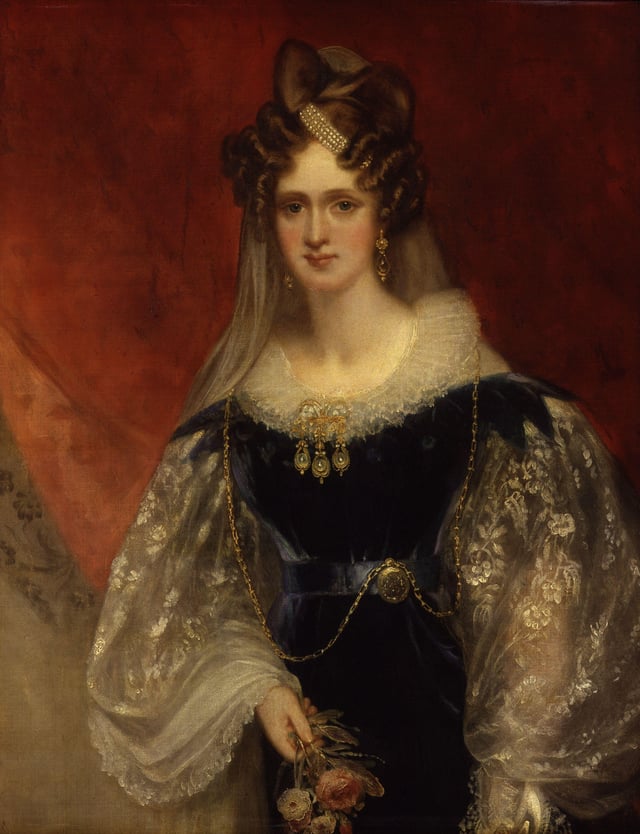
Queen Adelaide, after whom the city was named

In July 1876, the Illustrated Sydney News published a special supplement that included an early aerial view of the City of Adelaide, the River Torrens and portion of North Adelaide from a point above Pennington Terrace, North Adelaide.
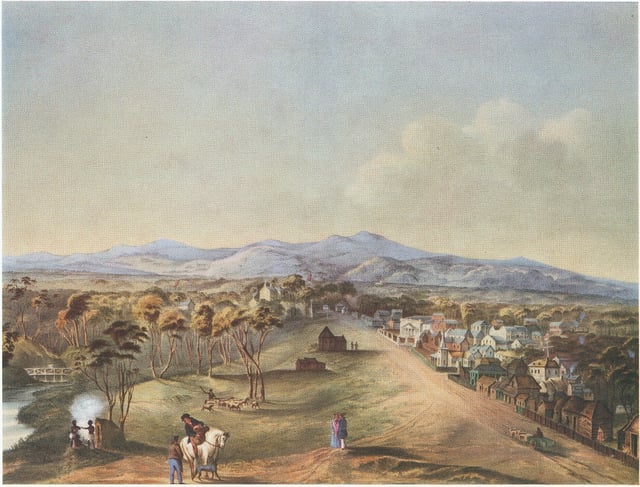
North Terrace in 1841
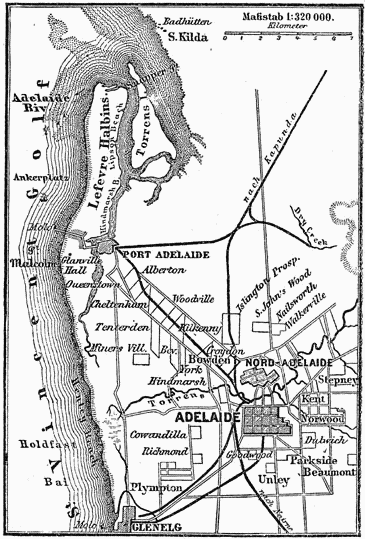
1888 map of Adelaide, showing the gradual development of its urban layout
South Australia was officially proclaimed a British colony on 28 December 1836, near The Old Gum Tree in what is now the suburb of Glenelg North. The event is commemorated in South Australia as Proclamation Day.[22] The site of the colony's capital was surveyed and laid out by Colonel William Light, the first Surveyor-General of South Australia, through the design made by the architect George Strickland Kingston.[23] The city was named after Adelaide of Saxe-Meiningen, queen consort to King William IV at the time.[24]
Adelaide was established as a planned colony of free immigrants, promising civil liberties and freedom from religious persecution, based upon the ideas of Edward Gibbon Wakefield. Wakefield had read accounts of Australian settlement while in prison in London for attempting to abduct an heiress,[25] and realised that the eastern colonies suffered from a lack of available labour, due to the practice of giving land grants to all arrivals.[26] Wakefield's idea was for the Government to survey and sell the land at a rate that would maintain land values high enough to be unaffordable for labourers and journeymen.[27] Funds raised from the sale of land were to be used to bring out working-class emigrants, who would have to work hard for the monied settlers to ever afford their own land.[28] As a result of this policy, Adelaide does not share the convict settlement history of other Australian cities like Sydney, Brisbane and Hobart.
As it was believed that in a colony of free settlers there would be little crime, no provision was made for a gaol in Colonel Light's 1837 plan. But by mid-1837 the South Australian Register was warning of escaped convicts from New South Wales and tenders for a temporary gaol were sought. Following a burglary, a murder, and two attempted murders in Adelaide during March 1838, Governor Hindmarsh created the South Australian Police Force (now the South Australia Police) in April 1838 under 21-year-old Henry Inman.[29] The first sheriff, Samuel Smart, was wounded during a robbery, and on 2 May 1838 one of the offenders, Michael Magee, became the first person to be hanged in South Australia.[30] William Baker Ashton was appointed governor of the temporary gaol in 1839, and in 1840 George Strickland Kingston was commissioned to design Adelaide's new gaol.[31] Construction of Adelaide Gaol commenced in 1841.[32]
Adelaide's early history was marked by economic uncertainty and questionable leadership. The first governor of South Australia, John Hindmarsh, clashed frequently with others, in particular the Resident Commissioner, James Hurtle Fisher. The rural area surrounding Adelaide was surveyed by Light in preparation to sell a total of over 405 km2 (156 sq mi) of land. Adelaide's early economy started to get on its feet in 1838 with the arrival of livestock from Victoria, New South Wales and Tasmania. Wool production provided an early basis for the South Australian economy. By 1860, wheat farms had been established from Encounter Bay in the south to Clare in the north.
George Gawler took over from Hindmarsh in late 1838 and, despite being under orders from the Select Committee on South Australia in Britain not to undertake any public works, promptly oversaw construction of a governor's house, the Adelaide Gaol, police barracks, a hospital, a customs house and a wharf at Port Adelaide. Gawler was recalled and replaced by George Edward Grey in 1841. Grey slashed public expenditure against heavy opposition, although its impact was negligible at this point: silver was discovered in Glen Osmond that year, agriculture was well underway, and other mines sprung up all over the state, aiding Adelaide's commercial development. The city exported meat, wool, wine, fruit and wheat by the time Grey left in 1845, contrasting with a low point in 1842 when one-third of Adelaide houses were abandoned.
Trade links with the rest of the Australian states were established after the Murray River was successfully navigated in 1853 by Francis Cadell, an Adelaide resident. South Australia became a self-governing colony in 1856 with the ratification of a new constitution by the British parliament. Secret ballots were introduced, and a bicameral parliament was elected on 9 March 1857, by which time 109,917 people lived in the province.[33]
In 1860 the Thorndon Park reservoir was opened, finally providing an alternative water source to the now turbid River Torrens. Gas street lighting was implemented in 1867, the University of Adelaide was founded in 1874, the South Australian Art Gallery opened in 1881 and the Happy Valley Reservoir opened in 1896. In the 1890s Australia was affected by a severe economic depression, ending a hectic era of land booms and tumultuous expansionism. Financial institutions in Melbourne and banks in Sydney closed. The national fertility rate fell and immigration was reduced to a trickle. The value of South Australia's exports nearly halved. Drought and poor harvests from 1884 compounded the problems, with some families leaving for Western Australia.[34] Adelaide was not as badly hit as the larger gold-rush cities of Sydney and Melbourne, and silver and lead discoveries at Broken Hill provided some relief. Only one year of deficit was recorded, but the price paid was retrenchments and lean public spending. Wine and copper were the only industries not to suffer a downturn.[35]
20th century
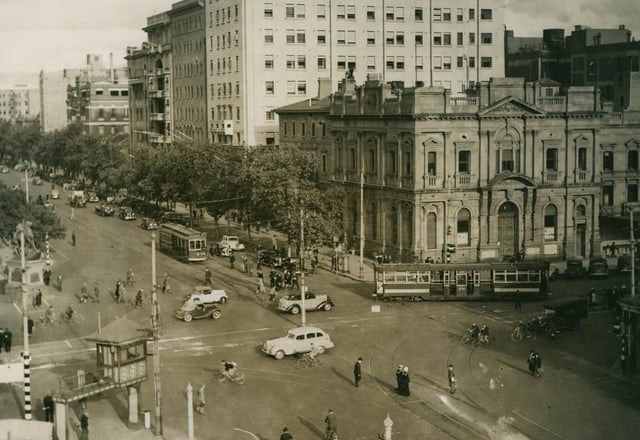
Intersection of North Terrace and King William Street viewed from Parliament House, 1938.
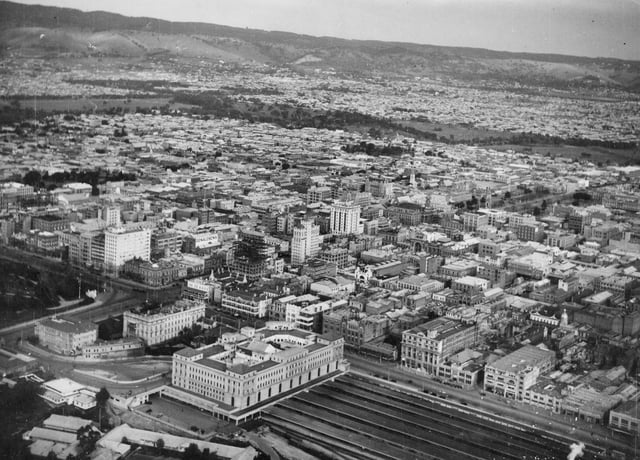
Aerial view of Adelaide in 1935, when it was Australia's third largest city. Note: Only the eastern half of Parliament House is completed.
Adelaide was Australia's third largest city for most of the 20th century.[36][37][38] Electric street lighting was introduced in 1900 and electric trams were transporting passengers in 1909. 28,000 men were sent to fight in World War I. Historian F. W. Crowley examined the reports of visitors in the early 20th century, noting that "many visitors to Adelaide admired the foresighted planning of its founders", as well as pondering the riches of the young city.[39] Adelaide enjoyed a postwar boom, entering a time of relative prosperity. Its population grew, and it became the third most populous metropolitan area in the country, after Sydney and Melbourne. Its prosperity was short-lived, with the return of droughts and the Great Depression of the 1930s. It later returned to fortune under strong government leadership.Secondary industries helped reduce the state's dependence on primary industries. World War II brought industrial stimulus and diversification to Adelaide under the Playford Government, which advocated Adelaide as a safe place for manufacturing due to its less vulnerable location.[40] Shipbuilding was expanded at the nearby port of Whyalla.
The South Australian Government in this period built on former wartime manufacturing industries but neglected cultural facilities which meant South Australia's economy lagged behind.[36] International manufacturers like General Motors Holden and Chrysler[41] made use of these factories around the Adelaide area in suburbs like Elizabeth, completing its transformation from an agricultural service centre to a 20th-century city. The Mannum–Adelaide pipeline brought River Murray water to Adelaide in 1955 and an airport opened at West Beach in 1955. Flinders University and the Flinders Medical Centre were established in the 1960s at Bedford Park, south of the city. Today, Flinders Medical Centre is one of the largest teaching hospitals in South Australia. In the post-war years around the early 1960s Adelaide was surpassed by Brisbane as Australia's third largest city.[36]
The Dunstan Governments of the 1970s saw something of an Adelaide 'cultural revival',[42] establishing a wide array of social reforms. The city became noted for its progressivism as South Australia became the first Australian state or territory to decriminalise homosexuality between consenting adults in 1975.[43] It also became a centre for the arts, building upon the biennial "Adelaide Festival of Arts" that commenced in 1960. Adelaide hosted the Formula One Australian Grand Prix between 1985 and 1996 on a street circuit in the city's east parklands; it moved to Melbourne in 1996.[44] The State Bank collapsed in 1991 during an economic recession; the effects lasted until 2004, when Standard & Poor's reinstated South Australia's AAA credit rating.[45] Since 1999, the Adelaide 500 Supercars race has made use of sections of the former Formula One circuit. Adelaide's tallest building, built in 1988, was originally known as the State Bank Building. In 1991 it was renamed the Santos Building and in 2006 it was renamed Westpac House, and it is currently the 160th tallest building in Australia.[46]
21st century
In the early years of the 21st century, a significant increase in the state government's spending on Adelaide's infrastructure occurred. The Rann government invested A$535 million in a major upgrade of the Adelaide Oval to enable Australian Football League to be played in the city centre[47] and more than A$2 billion to build a new Royal Adelaide Hospital on land adjacent to the Adelaide Railway Station.[48] The Glenelg tramline was extended through the city to Hindmarsh[49] and the suburban railway line extended south to Seaford.[50]
Following a period of stagnation in the 1990s and 2000s, Adelaide began several major developments and redevelopments. The Adelaide Convention Centre was redeveloped and expanded at a cost of A$350 million beginning in 2012.[51] Three historic buildings were adapted for modern use: the Torrens Building in Victoria Square as the Adelaide campus for Carnegie Mellon University, University College London, and Torrens University;[52] the Stock Exchange building as the Science Exchange of the Royal Institution Australia; and the Glenside Psychiatric Hospital as the Adelaide Studios of the SA Film Corporation. The government also invested more than A$2 billion to build a desalination plant, powered by renewable energy, as an 'insurance policy' against droughts affecting Adelaide's water supply.[53] The Adelaide Festival, Fringe, and Womadelaide became annual events.[54]
Geography

City map of the Adelaide metropolitan area.
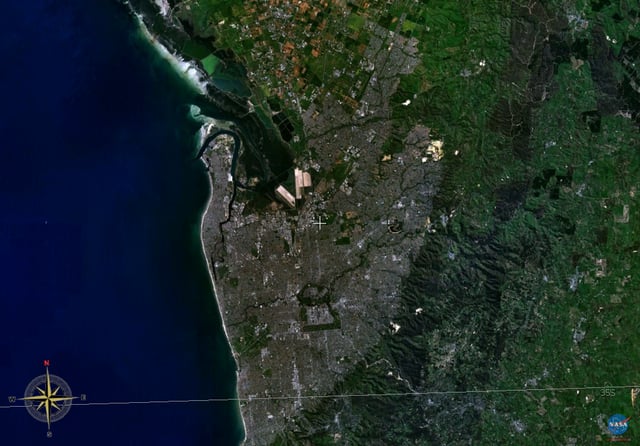
Satellite image of Adelaide's metropolitan area. The Adelaide Hills is the green area to the right of the Adelaide plains.
Adelaide is north of the Fleurieu Peninsula, on the Adelaide Plains between the Gulf St Vincent and the low-lying Mount Lofty Ranges. The city stretches 20 km (12 mi) from the coast to the foothills, and 90 km (56 mi) from Gawler at its northern extent to Sellicks Beach in the south. According to the Regional Development Australia, an Australian government planning initiative, the "Adelaide Metropolitan Region" has a total land area of 870 km2 (340 sq mi), while a more expansive definition by the Australian Bureau of Statistics defines a "Greater Adelaide" statistical area totalling 3,257.7 km2 (1,257.8 sq mi). The city sits at an average elevation of 50 metres (160 ft) above sea level. Mount Lofty, east of the Adelaide metropolitan region in the Adelaide Hills at an elevation of 727 metres (2,385 ft), is the tallest point of the city and in the state south of Burra.
Much of Adelaide was bushland before British settlement, with some variation – sandhills, swamps and marshlands were prevalent around the coast. The loss of the sandhills to urban development had a particularly destructive effect on the coastline due to erosion.[55] Where practical, the government has implemented programs to rebuild and vegetate sandhills at several of Adelaide's beachside suburbs. Much of the original vegetation has been cleared with what is left to be found in reserves such as the Cleland Conservation Park and Belair National Park. A number of creeks and rivers flow through the Adelaide region. The largest are the Torrens and Onkaparinga catchments. Adelaide relies on its many reservoirs for water supply with the Happy Valley Reservoir supplying around 40% and the much larger Mount Bold Reservoir 10% of Adelaide's domestic requirements respectively.
Adelaide and its surrounding area is one of the most seismically active regions in Australia. On 1 March 1954 at 3:40 am Adelaide experienced its largest recorded earthquake to date, with the epicentre 12 km from the city centre at Darlington, and a reported magnitude of 5.6.[56][57] There have been smaller earthquakes in 2010,[58] 2011,[59] 2014,[60] 2017,[61] and 2018.[62]
Urban layout
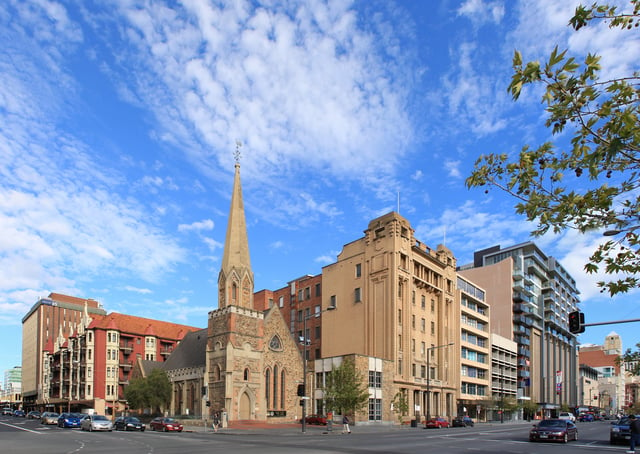
The corner of North Terrace (right) and Pulteney Street (left), looking south-west from Bonython Hall.
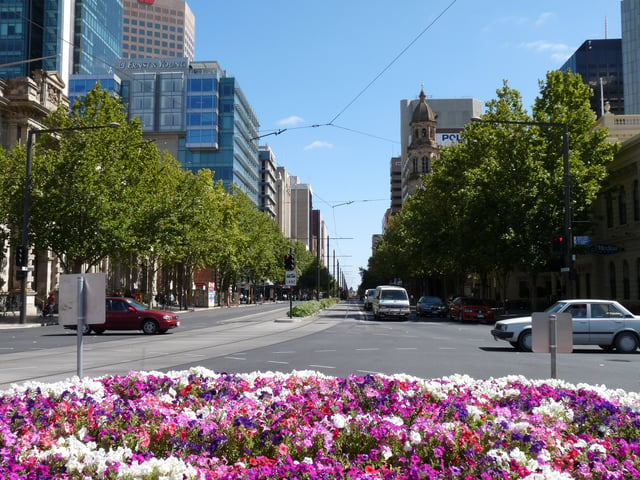
King William Street, one of the widest main streets in an Australian capital city, viewed from Victoria Square.
Adelaide is a planned city, designed by the first Surveyor-General of South Australia, Colonel William Light. His plan, now known as Light's Vision, arranged Adelaide in a grid, with five squares in the Adelaide city centre and a ring of parks, known as the Adelaide Parklands, surrounding it. Light's selection of the location for the city was initially unpopular with the early settlers, as well as South Australia's first governor, John Hindmarsh, due to its distance from the harbour at Port Adelaide, and the lack of fresh water there.[63] Light successfully persisted with his choice of location against this initial opposition.
The benefits of Light's design are numerous: Adelaide has had wide multi-lane roads from its beginning, an easily navigable cardinal direction grid layout and an expansive green ring around the city centre. There are two sets of ring roads in Adelaide that have resulted from the original design. The inner ring route (A21) borders the parklands, and the outer route (A3/A13/A16/A17) completely bypasses the inner city via (in clockwise order) Grand Junction Road, Hampstead Road, Ascot Avenue, Portrush Road, Cross Road and South Road.[64]
Suburban expansion has to some extent outgrown Light's original plan. Numerous former outlying villages and "country towns", as well as the satellite city of Elizabeth, have been enveloped by its suburban sprawl. Expanding developments in the Adelaide Hills region led to the construction of the South Eastern Freeway to cope with growth, which has subsequently led to new developments and further improvements to that transport corridor. Similarly, the booming development in Adelaide's South led to the construction of the Southern Expressway.
New roads are not the only transport infrastructure developed to cope with the urban growth. The O-Bahn Busway is an example of a unique solution to Tea Tree Gully's transport woes in the 1980s.[65] The development of the nearby suburb of Golden Grove in the late 1980s is an example of well-thought-out urban planning.
In the 1960s, a Metropolitan Adelaide Transport Study Plan was proposed in order to cater for the future growth of the city. The plan involved the construction of freeways, expressways and the upgrade of certain aspects of the public transport system. The then premier Steele Hall approved many parts of the plan and the government went as far as purchasing land for the project. The later Labor government elected under Don Dunstan shelved the plan, but allowed the purchased land to remain vacant, should the future need for freeways arise. In 1980, the Liberal party won government and premier David Tonkin committed his government to selling off the land acquired for the MATS plan, ensuring that even when needs changed, the construction of most MATS-proposed freeways would be impractical. Some parts of this land have been used for transport, (e.g. the O-Bahn Busway and Southern Expressway), while most has been progressively subdivided for residential use.
In 2008, the SA Government announced plans for a network of transport-oriented developments across the Adelaide metropolitan area and purchased a 10 hectare industrial site at Bowden for $52.5 million as the first of these developments.[66][67] The site covers 102,478 square metres, or about 10 hectares, and is bounded by Park Terrace to the south, the Adelaide to Outer Harbour railway line to the west, Drayton Street to the north and Sixth and Seventh Streets to the east.
Housing
Historically, Adelaide's suburban residential areas have been characterised by single-storey detached houses built on 1,000-square-metre (1⁄4-acre) blocks. A relative lack of suitable, locally-available timber for construction purposes led to the early development of a brick-making industry, as well as the use of stone, for houses and other buildings. By 1891 68% of houses were built of stone, 15% of timber, and 10% of brick, with brick also being widely used in stone houses for quoins, door and window surrounds, and chimneys and fireplaces.[68]
There is a wide variety in the styles of these predominately brick, and to a lesser degree, stone, and/or stone-faced, single-storey detached houses. After both of the World Wars, the use of red bricks was popular. In the 1960s, cream bricks became popular, and in the 1970s, deep red and brown bricks became popular. Until the 1970s, roofs tended to be clad with corrugated (iron) steel or clay tiles (usually red clay). Since then, cement tiles and Colorbond(R) corrugated (and other types of) steel have also become popular. Most roofs are pitched; flat roofs are not common. Up to the 1970s, the majority of houses were of "double brick" construction on concrete footings, with timber floors laid on joists supported by "dwarf walls". Due to Adelaide's reactive soils (particularly Keswick Clay, black earth and some red-brown earth soils[69]), since then houses have mainly been constructed of "brick veneer" over a timber frame (and more recently, over a light steel frame) on a concrete slab foundation.[70] The use of precast concrete panels for floor and wall construction has also increased.[70] In addition to this, a significant factor in Adelaide's suburban history is the role of the South Australian Housing Trust.
Climate
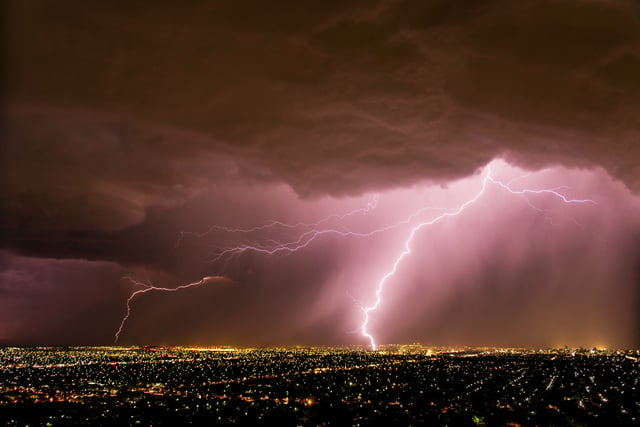
A spring storm over Adelaide
Adelaide has a hot-summer Mediterranean climate (Köppen climate classification: Csa) in Kent Town.[71] with warm to hot dry summers and cool to mild winters and with most precipitation falling in the winter months, leading to the suggestion that the climate be classified as a "cold monsoon".[72] Rainfall is unreliable, light and infrequent throughout summer. In contrast, the winter has fairly reliable rainfall with June being the wettest month of the year, averaging around 80 mm. Frosts are occasional, with the most notable occurrences in July 1908 and July 1982. Hail is also common in winter. Adelaide is a windy city with significant wind chill in winter, which makes the temperature seem colder than it actually is. Snowfall in the metropolitan area is extremely uncommon, although light and sporadic falls in the nearby hills and at Mount Lofty occur during winter. Dewpoints in the summer typically range from 8 to 10 °C (46 to 50 °F). There are usually five to six days in summer where the temperature reaches 40.0 °C (104.0 °F) or above, although the frequency of these temperatures has been increasing in recent years.
The average sea temperature ranges from 13.7 °C (56.7 °F) in August to 21.2 °C (70.2 °F) in February.[73]
| Climate data for Adelaide (Kent Town, 1977–2013) | |||||||||||||
|---|---|---|---|---|---|---|---|---|---|---|---|---|---|
| Month | Jan | Feb | Mar | Apr | May | Jun | Jul | Aug | Sep | Oct | Nov | Dec | Year |
| Average high °C (°F) | 29.4 (84.9) | 29.5 (85.1) | 26.5 (79.7) | 22.7 (72.9) | 19.0 (66.2) | 16.1 (61.0) | 15.3 (59.5) | 16.7 (62.1) | 19.1 (66.4) | 22.1 (71.8) | 25.3 (77.5) | 27.2 (81.0) | 22.4 (72.3) |
| Average low °C (°F) | 17.2 (63.0) | 17.3 (63.1) | 15.4 (59.7) | 12.5 (54.5) | 10.3 (50.5) | 8.2 (46.8) | 7.5 (45.5) | 8.2 (46.8) | 9.8 (49.6) | 11.5 (52.7) | 14.0 (57.2) | 15.6 (60.1) | 12.3 (54.1) |
| Average rainfall mm (inches) | 20.9 (0.82) | 15.9 (0.63) | 27.4 (1.08) | 39.4 (1.55) | 60.8 (2.39) | 78.8 (3.10) | 77.4 (3.05) | 67.3 (2.65) | 59.7 (2.35) | 42.0 (1.65) | 29.6 (1.17) | 29.1 (1.15) | 548.3 (21.59) |
| Average rainy days(≥ 0.2 mm) | 4.7 | 3.6 | 5.9 | 8.1 | 12.5 | 15.0 | 16.4 | 16.3 | 13.5 | 10.0 | 8.1 | 7.1 | 121.2 |
| Average afternoon relative humidity (%) | 36 | 36 | 41 | 47 | 55 | 61 | 60 | 55 | 51 | 45 | 40 | 39 | 47 |
| Mean monthly sunshine hours | 325.5 | 285.3 | 266.6 | 219.0 | 167.4 | 138.0 | 148.8 | 186.0 | 204.0 | 257.3 | 273.0 | 294.5 | 2,765.4 |
| Source: Bureau of Meteorology.[74][75][76] | |||||||||||||
Liveability
Adelaide has been consistently listed in the world's top 10 most liveable cities through the 2010s by The Economist Intelligence Unit, although it dropped to tenth place in 2018 after holding fifth position in the previous three years.[77][78][79][80] It was ranked the most liveable city in Australia by the Property Council of Australia, based on surveys of residents’ views of their own city, between 2010 and 2013,[81][82][83] dropping to second place in 2014.[84]
Governance
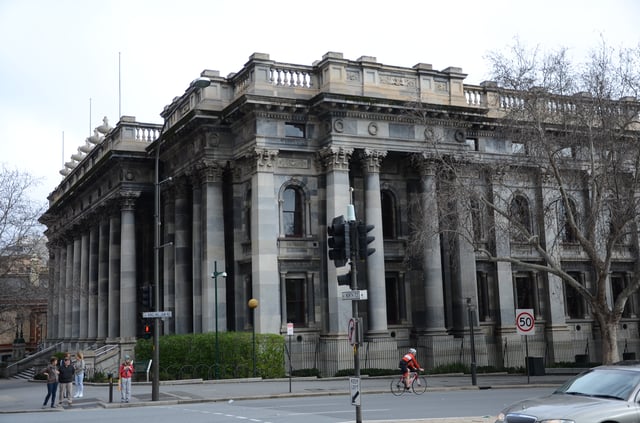
Parliament House, Adelaide
Adelaide, as the capital of South Australia, is the seat of the Government of South Australia. As Adelaide is South Australia's capital and most populous city, the State Government co-operates extensively with the City of Adelaide. In 2006, the Ministry for the City of Adelaide was created to facilitate the State Government's collaboration with the Adelaide City Council and the Lord Mayor to improve Adelaide's image. The State Parliament's Capital City Committee[85] is also involved in the governance of the City of Adelaide, being primarily concerned with the planning of Adelaide's urban development and growth.
Reflecting South Australia's status as Australia's most centralised state, Adelaide elects a substantial majority of the South Australian House of Assembly. Of the 47 seats in the chamber, 34 seats (three-quarters of the legislature) are based in Adelaide, and two rural seats include Adelaide suburbs.
Local governments
The Adelaide metropolitan area is divided between nineteen local government areas. At its centre, the City of Adelaide administers the Adelaide city centre, North Adelaide, and the surrounding Adelaide Parklands. It is the oldest municipal authority in Australia and was established in 1840, when Adelaide and Australia's first mayor, James Hurtle Fisher, was elected. From 1919 onwards, the City has had a Lord Mayor, the current being Lord Mayor The Right Honourable Sandy Verschoor.
Demography
Compared with Australia's four other major state capitals, Adelaide is growing at a much slower rate. In 2017, it had a metropolitan population (including suburbs) of more than 1,333,927,[6] making it Australia's fifth-largest city. Some 77%[88] of the population of South Australia are residents of the Adelaide metropolitan area, making South Australia one of the most centralised states.
Major areas of population growth in recent years have been in outer suburbs such as Mawson Lakes and Golden Grove. Adelaide's inhabitants occupy 366,912 houses, 57,695 semi-detached, row terrace or town houses and 49,413 flats, units or apartments.[89]
About one sixth (17.1%) of the population had university qualifications. The number of Adelaideans with vocational qualifications (such as tradespersons) fell from 62.1% of the labour force in the 1991 census to 52.4% in the 2001 census.
Adelaide is ageing more rapidly than other Australian capital cities. More than a quarter (27.5%) of Adelaide's population is aged 55 years or older, in comparison to the national average of 25.6%. Adelaide has the lowest number of children (under-15-year-olds), who comprised 17.7% of the population, compared to the national average of 19.3%.[89]
Ancestry and immigration

Chinatown on Moonta Street in the Market precinct
Suburbs including Newton, Payneham and Campbelltown in the east and Torrensville, West Lakes and Fulham to the west, have large Greek and Italian communities. The Italian consulate is located in the eastern suburb of Payneham. Large Vietnamese populations are settled in the north-western suburbs of Woodville, Kilkenny, Pennington, Mansfield Park and Athol Park and also Parafield Gardens and Pooraka in Adelaide's north. Migrants from India and Sri Lanka have settled into inner suburban areas of Adelaide including the inner northern suburbs of Blair Athol, Kilburn and Enfield and the inner southern suburbs of Plympton, Park Holme and Kurralta Park.
Suburbs such as Para Hills, Salisbury, Ingle Farm and Blair Athol in the north and Findon, West Croydon and Seaton and other Western suburbs have sizeable Afghan communities. Chinese migrants favour settling in the eastern and north eastern suburbs including Kensington Gardens, Greenacres, Modbury and Golden Grove. Mawson Lakes has a large international student population, due to its proximity to the University of South Australia campus.
1.4% of the population, or 18,403 people, identified as Indigenous Australians (Aboriginal Australians and Torres Strait Islanders) in 2016.[5][90]
Language
Religion
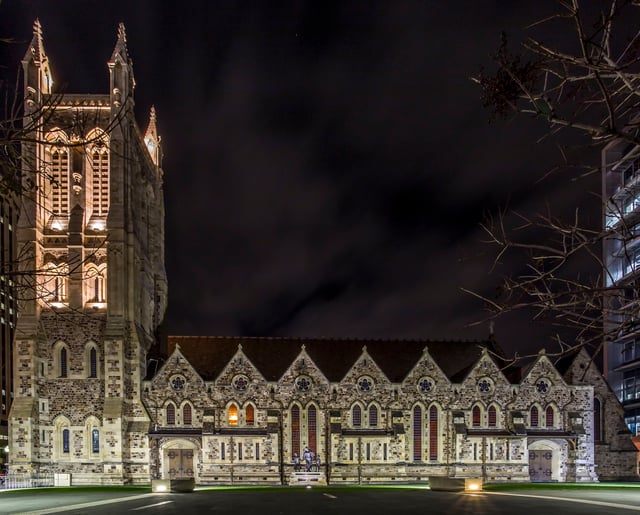
Saint Francis Xavier's Cathedral in Victoria Square
Adelaide was founded on a vision of religious tolerance that attracted a wide variety of religious practitioners. This led to it being known as The City of Churches.[92][93][94] But approximately 28% of the population expressed no religious affiliation in the 2011 Census, compared with the national average of 22.3%, making Adelaide one of Australia's least religious cities. Over half of the population of Adelaide identifies as Christian, with the largest denominations being Catholic (21.3%), Anglican (12.6%), Uniting Church (7.6%) and Eastern Orthodox (3.5%).[95]
The Jewish community of the city dates back to 1840. Eight years later, 58 Jews lived in the city.[96] A synagogue was built in 1871, when 435 Jews lived in the city. Many took part in the city councils, such as Judah Moss Solomon (1852–66) and others after him. Three Jews have been elected to the position of city mayor.[97] In 1968, the Jewish population of Adelaide numbered about 1,200;[98] in 2001, according to the Australian census, 979 persons declared themselves to be Jewish by religion.[96] In 2011, over 1,000 Jews were living in the city, operating an orthodox and a reform school, in addition to a virtual Jewish museum.[99]
The "Afghan" community in Australia first became established in the 1860s when camels and their Pathan, Punjabi, Baluchi and Sindhi handlers began to be used to open up settlement in the continent's arid interior.[100] Until eventually superseded by the advent of the railways and motor vehicles, camels played an invaluable economic and social role in transporting heavy loads of goods to and from isolated settlements and mines. This is acknowledged by the name of The Ghan, the passenger train operating between Adelaide, Alice Springs, and Darwin. The Central Adelaide Mosque is regarded as Australia's oldest permanent mosque; an earlier mosque at Marree in northern South Australia, dating from 1861–62 and subsequently abandoned or demolished, has now been rebuilt.
Economy
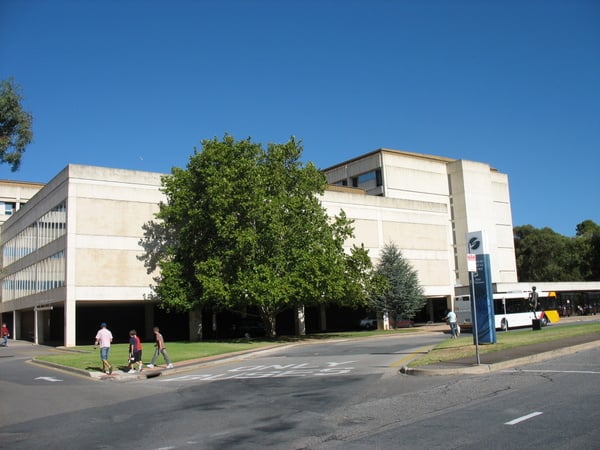
Flinders Medical Centre. Health care and social assistance is the largest ABS-defined employment sector in South Australia.[101]
South Australia's largest employment sectors are health care and social assistance,[101][102] surpassing manufacturing in SA as the largest employer since 2006–07.[101][102] In 2009–10, manufacturing in SA had average annual employment of 83,700 persons compared with 103,300 for health care and social assistance.[101] Health care and social assistance represented nearly 13% of the state average annual employment.[103] The Adelaide Hills wine region is an iconic and viable economic region for both the state and country in terms of wine production and sale. The 2014 vintage is reported as consisting of 5,836 t (5,744 long tons; 6,433 short tons) red grapes crushed valued at A$8,196,142 and 12,037 t (11,847 long tons; 13,269 short tons) white grapes crushed valued at $14,777,631.[104]
The retail trade is the second largest employer in SA (2009–10), with 91,900 jobs, and 12 per cent of the state workforce.[103]
Manufacturing, defence technology, high-tech electronic systems and research, commodity export and corresponding service industries all play a role in the SA economy. Almost half of all cars produced in Australia were made in Adelaide at the General Motors Holden plant in Elizabeth.[105] The site ceased operating in November 2017.
The collapse of the State Bank in 1992 resulted in large levels of state public debt (as much as A$4 billion). The collapse meant that successive governments enacted lean budgets, cutting spending, which was a setback to the further economic development of the city and state. The debt has more recently been reduced with the State Government once again receiving a AAA+ Credit Rating.[106]
The global media conglomerate News Corporation was founded in, and until 2004 incorporated in, Adelaide and it is still considered its 'spiritual' home by Rupert Murdoch. Australia's largest oil company, Santos, prominent South Australian brewery, Coopers, and national retailer Harris Scarfe also call Adelaide their home.
Defence industry

The Adelaide-built Collins-class submarine HMAS Rankin entering Pearl Harbor, August 2004.
Adelaide is home to a large proportion of Australia's defence industries, which contribute over A$1 billion to South Australia's Gross State Product.[107] The principal government military research institution, the Defence Science and Technology Organisation, and other defence technology organisations such as BAE Systems Australia and Lockheed Martin Australia, are north of Salisbury and west of Elizabeth in an area now called "Edinburgh Parks", adjacent to RAAF Base Edinburgh.
Others, such as Saab Systems and Raytheon, are in or near Technology Park. ASC Pty Ltd, based in the industrial suburb of Osborne. South Australia was charged with constructing Australia's Collins class submarines and more recently the A$6 billion contract to construct the Royal Australian Navy's new air-warfare destroyers.[108]
Employment statistics
As of November 2015, Greater Adelaide had an unemployment rate of 7.4% with a youth unemployment rate of 15%.[109]
The median weekly individual income for people aged 15 years and over was $447 per week in 2006, compared with $466 nationally. The median family income was $1,137 per week, compared with $1,171 nationally.[110] Adelaide's housing and living costs are substantially lower than that of other Australian cities, with housing being notably cheaper. The median Adelaide house price is half that of Sydney and two-thirds that of Melbourne. The three-month trend unemployment rate to March 2007 was 6.2%.[111] The Northern suburbs' unemployment rate is disproportionately higher than the other regions of Adelaide at 8.3%, while the East and South are lower than the Adelaide average at 4.9% and 5.0% respectively.[112]
House prices
Over the decade March 2001 – March 2010, Metropolitan Adelaide median house prices approximately tripled. (approx. 285% – approx. 11%p.a. compounding) In the five years March 2007 – March 2012, prices increased by approx. 27% – approx. 5%p.a. compounding. March 2012 – March 2017 saw a further increase of 19% – approx. 3.5%p.a. compounding.[113][114][115][116]
In summary:
| March | 2001 | 2002 | 2003 | 2004 | 2005 | 2006 | 2007 | 2008 | 2009 | 2010 |
|---|---|---|---|---|---|---|---|---|---|---|
| Median | $140,000 | $170,000 | $200,000 | $250,000 | $270,000 | $280,000 | $300,000 | $360,000 | $350,000 | $400,000 |
| % change | 21% | 18% | 25% | 8% | 4% | 7% | 20% | −3% | 14% | |
| March | 2011 | 2012 | 2013 | 2014 | 2015 | 2016 | 2017 | 2018 | 2019 | 2020 |
| Median | $400,000 | $380,000 | $393,000 | $413,000 | $425,000 | $436,000 | $452,000 | $470,000 | $478,500 | |
| % change | 0% | −5% | 3% | 5% | 3% | 3% | 4% | |||
| *All numbers approximate and rounded. Since March 2012, the REISA[117] no longer release a median house price for the Adelaide Metropolitan area, so figures retrieved are from Dept of the Premier and Cabinet.*[116] | ||||||||||
Each quarter, The Alternative and Direct Investment Securities Association (ADISA) publishes a list of median house sale prices by suburb and Local Government Area. (Previously, this was done by REISA[117]) Due to the small sizes of many of Adelaide's suburbs, the low volumes of sales in these suburbs, and (over time) the huge variations in the numbers of sales in a suburb in a quarter, statistical analysis of "the most expensive suburb" is unreliable; the suburbs appearing in the "top 10 most expensive suburbs this quarter" list is constantly varying. Quarterly Reports for the last two years can be found on the REISA website.[118]
Education and research
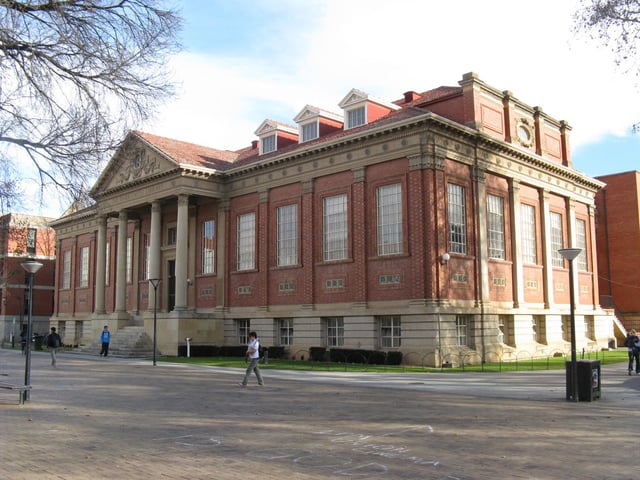
Barr Smith Library, part of the University of Adelaide
Education forms an increasingly important part of the city's economy, with the South Australian Government and educational institutions attempting to position Adelaide as "Australia's education hub" and marketing it as a "Learning City."[119] The number of international students studying in Adelaide has increased rapidly in recent years to 30,726 in 2015, of which 1,824 were secondary school students.[120] In addition to the city's existing institutions, foreign institutions have been attracted to set up campuses in order to increase its attractiveness as an education hub.[121][122] Adelaide is the birthplace of three Nobel laureates, more than any other Australian city: physicist William Lawrence Bragg and pathologists Howard Florey and Robin Warren, all of whom completed secondary and tertiary education at St Peter's College and the University of Adelaide.
Primary and secondary education
At the level of primary and secondary education, there are two systems of school education. There is a public system operated by the South Australian Government and a private system of independent and Catholic schools. All schools provide education under the South Australian Certificate of Education (SACE) or, to a lesser extent, the International Baccalaureate (IB), with Adelaide having the highest number of IB schools in Australia.[123]
Tertiary education
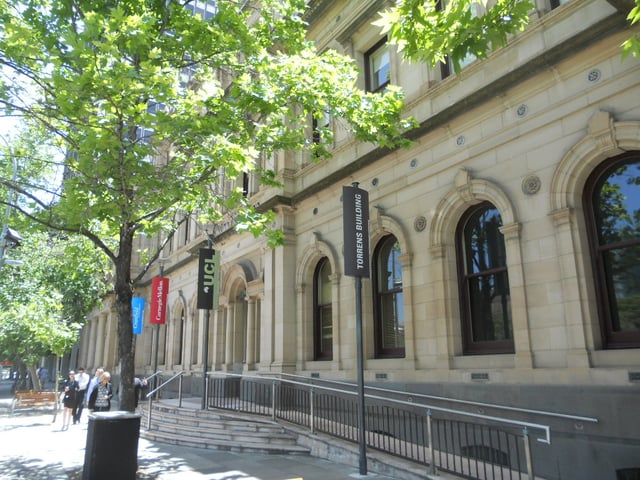
Historic Torrens Building in Victoria Square houses campuses of several international universities operating in South Australia.
There are three public universities local to Adelaide, as well as one private university and three constituent colleges of foreign universities. Flinders University of South Australia, the University of Adelaide, the University of South Australia and Torrens University Australia—part of the Laureate International Universities are based in Adelaide. The University of Adelaide was ranked in the top 150 universities worldwide. Flinders ranked in the top 250 and Uni SA in the top 300. Torrens University Australia is part of an international network of over 70 higher education institutions in more than 30 countries worldwide. The historic Torrens Building in Victoria Square[124] houses Carnegie Mellon University's Heinz College Australia, and University College London's School of Energy and Resources (Australia), and constitute the city's international university precinct.[125]
The University of Adelaide, with 25,000 students,[126] is Australia's third-oldest university and a member of the leading "Group of Eight". It has five campuses throughout the state, including two in the city-centre, and a campus in Singapore. The University of South Australia, with 37,000 students,[127] has two North Terrace campuses, three other campuses in the metropolitan area and campuses at Whyalla and Mount Gambier. Flinders University, with 25,184 domestic and international students,[128] is in the southern suburb of Bedford Park, alongside the Flinders Medical Centre, another campus in neighbouring Tonsley, and maintains a small city campus in Victoria Square. The plaza on the Bedford Park campus was revamped in 2014 and officially re-opened in 2016.[129]
There are several South Australian TAFE (Technical and Further Education) campuses in the metropolitan area that provide a range of vocational education and training. The Adelaide College of the Arts, as a school of TAFE SA, provides nationally recognised training in visual and performing arts.
Research
In addition to the universities, Adelaide is home to a number of research institutes, including the Royal Institution of Australia, established in 2009 as a counterpart to the two-hundred-year-old Royal Institution of Great Britain.[130] Many of the organisations involved in research tend to be geographically clustered throughout the Adelaide metropolitan area:
The east end of North Terrace: IMVS;[131] Hanson Institute;[132] RAH; National Wine Centre.
The west end of North Terrace: South Australian Health and Medical Research Institute (SAHMRI), located next to the new Royal Adelaide Hospital.
The Waite Research Precinct: SARDI Head Office and Plant Research Centre; AWRI;[133] ACPFG;[134] CSIRO research laboratories.[135] SARDI also has establishments at Glenside[136] and West Beach.[137]
Edinburgh, South Australia: DSTO; BAE Systems (Australia); Lockheed Martin Australia Electronic Systems.
Technology Park (Mawson Lakes): BAE Systems; Optus; Raytheon; Topcon; Lockheed Martin Australia Electronic Systems.
Research Park at Thebarton: businesses involved in materials engineering, biotechnology, environmental services, information technology, industrial design, laser/optics technology, health products, engineering services, radar systems, telecommunications and petroleum services.
Science Park (adjacent to Flinders University): Playford Capital.
The Basil Hetzel Institute for Translational Health Research[138] in Woodville the research arm of the Queen Elizabeth Hospital, Adelaide
The Joanna Briggs Institute, a global research collaboration for evidence-based healthcare with its headquarters in North Adelaide.
Cultural life
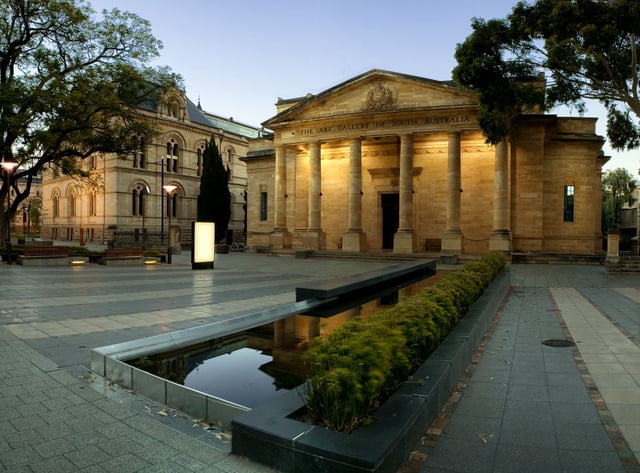
The Art Gallery of South Australia, and part of the South Australian Museum on North Terrace
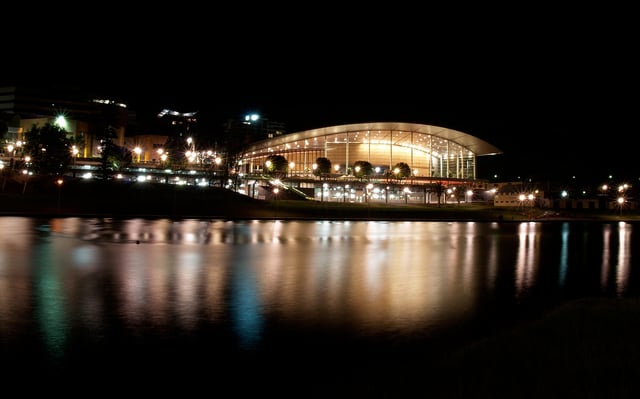
The Adelaide Convention Centre, the first of its kind in South Australia, is situated on the River Torrens. Photo taken in 2007.
While established as a British province, and very much English in terms of its culture, Adelaide attracted immigrants from other parts of Europe early on, including German and other European non-conformists escaping religious persecution. The first German Lutherans arrived in 1838[139] bringing with them the vine cuttings that they used to found the acclaimed wineries of the Barossa Valley.
The Royal Adelaide Show is an annual agricultural show and state fair, established in 1839 and now a huge event held in the Adelaide Showground annually.
Adelaide's arts scene flourished in the 1960s and 1970s with the support of successive premiers from both major political parties. The renowned Adelaide Festival of Arts was established in 1960 under Thomas Playford, which in the same year spawned an unofficial uncurated series of performances and exhibits which grew into the Adelaide Fringe. Construction of the Adelaide Festival Centre began under Steele Hall in 1970 and was completed under the subsequent government of Don Dunstan, who also established the South Australian Film Corporation in 1972 and the State Opera of South Australia in 1976.
Over time, the Adelaide Festival expanded to include Adelaide Writers' Week and WOMADelaide, and other separate festivals were established, such as the Adelaide Cabaret Festival (2002), the Adelaide Festival of Ideas (1999), the Adelaide Film Festival (2013), FEAST (1999, a queer culture) and Tasting Australia (1997, a food and wine affair). With the Festival, the Fringe, WOMADelaide, Writers' Week and the Adelaide 500 street motor racing event (along with evening music concerts) all happening in early March, the period has become known colloquially as "Mad March".
There are many international cultural fairs, most notably the German Schützenfest and Greek Glendi. Adelaide is home to the Adelaide Christmas Pageant, the world's largest Christmas parade.
North Terrace institutions
As the state capital, Adelaide is home to a great number of cultural institutions with many along the boulevard of North Terrace. The Art Gallery of South Australia, with around 35,000 works, holds Australia's second largest state-based collection. Adjacent are the South Australian Museum and State Library of South Australia, while the Adelaide Botanic Garden, National Wine Centre and Tandanya National Aboriginal Cultural Institute are nearby in the East End of the city. In the back of the State Library lies the Migration Museum, Australia's oldest museum of its kind.
Further west, the Lion Arts Centre is home to ACE Open, which showcases contemporary art, Dance Hub SA and other studio and arts industry office spaces. The Mercury Cinema and JamFactory (ceramics and design gallery) are just around the corner.
Performing arts and music venues
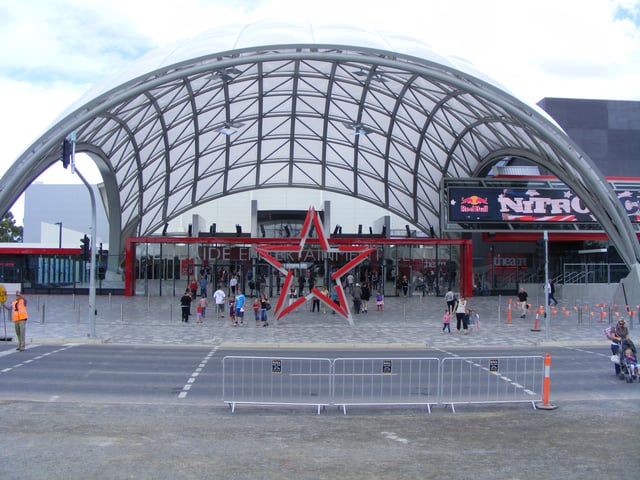
The Adelaide Entertainment Centre, the largest indoor sports and entertainment venue in Adelaide
The Adelaide Festival Centre (which includes the Dunstan Playhouse, Festival Theatre and Space Theatre), on the banks of the Torrens, is the focal point for much of the cultural activity in the city and home to the State Theatre Company of South Australia. Other live music and theatre venues include the Adelaide Entertainment Centre; Adelaide Oval; Memorial Drive Park; Thebarton Theatre; Adelaide Town Hall; Her Majesty's Theatre; Queen's Theatre; Holden Theatres and the Hopgood Theatre.
The Lion Arts Factory, within the Lion Arts Centre, hosts contemporary music in a wide range of genres, as does "The Gov" in Hindmarsh. The city also has numerous smaller theatres, pubs and cabaret bars which host performances.
Live music
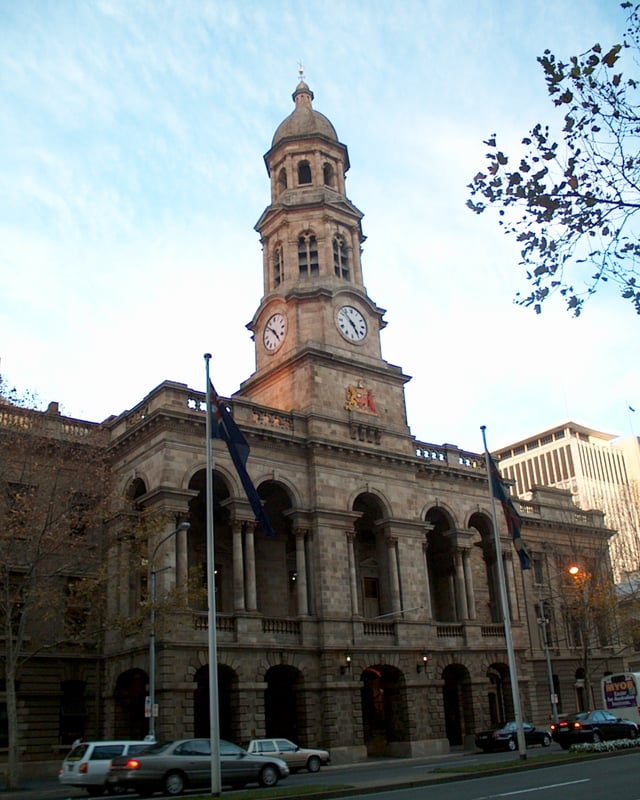
The Adelaide Town Hall
In 2015, it was said that there were now more live music venues per capita in Adelaide than any other capital city in the southern hemisphere,[142][143] Lonely Planet labelled Adelaide “Australia’s live music city”,[144] and the city was recognised as a "City of Music" by the UNESCO Creative Cities Network.[145]
In addition to its own WOMADelaide, Adelaide attracts several touring music festivals, including Creamfields, Laneway and Groovin'.
Adelaide has produced musical groups and individuals who have achieved national and international fame. These include the Adelaide Symphony Orchestra, the Adelaide Youth Orchestra, rock bands The Angels, Cold Chisel, The Superjesus, Wolf & Cub, roots/blues group The Audreys, internationally acclaimed metal acts I Killed The Prom Queen and Double Dragon, popular Australian hip-hop outfit Hilltop Hoods, pop acts like Sia, Orianthi, Guy Sebastian, and Wes Carr, as well as internationally successful tribute act, The Australian Pink Floyd Show.
Noted rocker Jimmy Barnes (formerly lead vocalist with Cold Chisel) spent most of his youth in the northern suburb of Elizabeth. Paul Kelly grew up in Adelaide and was head prefect at Rostrevor College. The first Australian Idol winner, Guy Sebastian, hails from the north-eastern suburb of Golden Grove.
Dance
Adelaide plays host to two of Australia's leading contemporary dance companies. The Australian Dance Theatre and Dance Hub SA (formerly Leigh Warren & Dancers) contribute to state festivals and perform nationally and internationally. Restless Dance Theatre is also based in Adelaide and is nationally recognised for working with disabled and non-disabled dancers to use movement as a means of expression.
Media
Newspapers
Newspapers in Adelaide are dominated by News Corporation publications—Adelaide being the birthplace of News Corporation itself. The only South Australian daily newspaper is The Advertiser, published by News Corporation six days a week. The same group publishes a Sunday paper, the Sunday Mail.
There are eleven suburban community newspapers published weekly, known collectively as the Messenger Newspapers, also published by a subsidiary of News Corporation. The Independent Weekly was a small independent newspaper providing an alternative view, but ceased publishing its print edition in November 2010 and now exists as a digital daily newsletter only. The Adelaide Review is a free paper published fortnightly, and other independent magazine-style papers are published, but are not as widely available.
Television
Adelaide is served by numerous digital free-to-air television channels:
ABC
ABC (ABC broadcast in HD)
ABC Comedy/KIDS
ABC Me
ABC News
SBS
SBS HD (SBS broadcast in HD)
SBS World Movies HD
SBS Viceland HD
SBS Food
NITV
Seven
7HD (Seven broadcast in HD)
7Two
7mate
7flix
Racing.com
Nine
9HD (Nine broadcast in HD)
9Gem
9Go!
9Life
Ten
Ten HD (Ten broadcast in HD)
10 Bold
10 Peach
TVSN
Spree TV
C44 Adelaide (Adelaide's community TV station)
All of the five Australian national television networks broadcast both high-definition digital and standard-definition digital television services in Adelaide. They share three transmission towers on the ridge near the summit of Mount Lofty. There are two other transmission sites at 25 Grenfell Street, Adelaide and Elizabeth Downs.[146] The two government-funded stations are run by the Australian Broadcasting Corporation (ABC South Australia) and the Special Broadcasting Service (SBS). The Seven Network and Network Ten both own their Adelaide stations (SAS-7 and ADS-10 respectively). Adelaide's NWS-9 is part of the Nine Network. Adelaide also has a community television station, Channel 44.
As part of a nationwide phase-out of analogue television in Australia, Adelaide's analogue television service was shut down on 2 April 2013.[147]
The Foxtel pay TV service is also available via cable or satellite to the entire metropolitan area.
Radio
There are 20 radio stations that serve the metropolitan area, as well as four stations that serve only parts of the metropolitan area; six commercial stations, six community stations, six national stations and two narrowcast stations.[148]
DAB+ digital radio has been broadcasting in metropolitan Adelaide since 20 May 2009, and currently offers a choice of 41 stations all operated by the existing licensed radio broadcasters, which includes high-quality simulcast of all AM and FM stations.
Crime
Sport
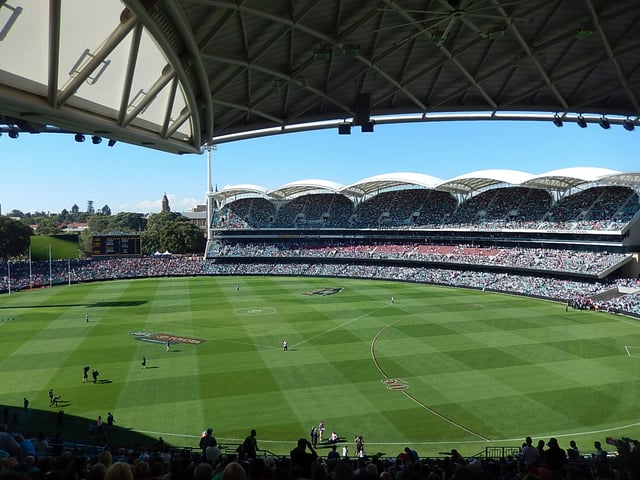
Adelaide Oval is the home of Australian Rules football and cricket in South Australia.

Hindmarsh Stadium hosts Adelaide United.
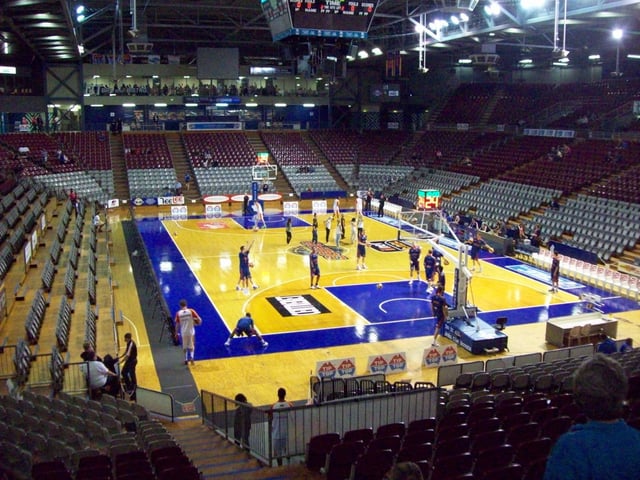
Titanium Security Arena is home to basketball in South Australia.
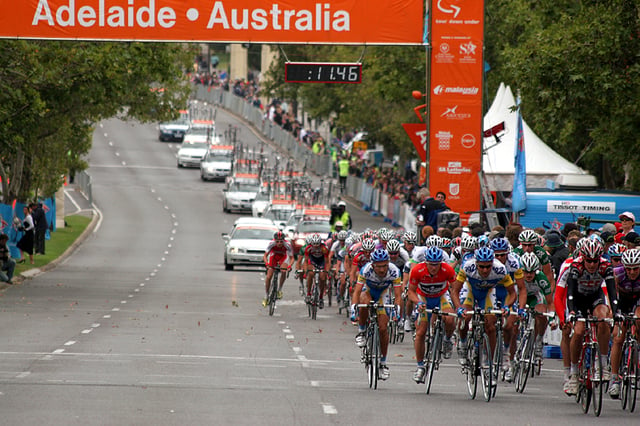
The Tour Down Under is the first event of the UCI World Tour calendar.
The main sports played professionally in Adelaide are Australian Rules football, association football (soccer), cricket, netball, and basketball. Adelaide is the home of two Australian Football League teams: the Adelaide Football Club and Port Adelaide Football Club, and one A-League soccer team, Adelaide United. A local Australian rules football league, the SANFL, is made up of 10 teams from around Adelaide. The SANFL has been in operation since 1877 when it began as the South Australian Football Association (SAFL) before changing its name to the SANFL in 1927. The SANFL is the oldest surviving football league of any code played in Australia. Adelaide has developed a strong culture of attracting crowds to major sporting events.[149] Until the completion of the 2012–14 renovation and upgrade of the Adelaide Oval, most large sporting events took place at either AAMI Stadium (the then home base of the Adelaide Crows, and the then Port Adelaide's home game venue), or the historic Adelaide Oval, home of the Southern Redbacks and the Adelaide Strikers cricket teams. Since completion of the upgrade, home games for Adelaide Crows and Port Adelaide now take place at Adelaide Oval.
Since 1884, Adelaide Oval has also hosted an international cricket test every summer, along with a number of One Day International cricket matches. Memorial Drive Park, adjacent to the Adelaide Oval, used to host Davis Cup and other major tennis events, including the Australian Open and (until 2009) the Adelaide International (now known as the Brisbane International). Adelaide's professional association football team, Adelaide United, play in the A-League. Founded in 2003, their home ground is Hindmarsh Stadium, which has a capacity of 17,000 and is one of the few purpose-built soccer stadia in Australia. Prior to United's foundation, Adelaide City and West Adelaide represented the city in the National Soccer League. The two sides, which contest the Adelaide derby against one another, now play in the National Premier Leagues South Australia.
For two years, 1997 and 1998, Adelaide was represented in Australia's top level rugby league, after the New South Wales Rugby League had played a single game per season at the Adelaide Oval for five years starting in 1991.[150] The Adelaide Rams were formed and played in the breakaway Super League (SL) competition in 1997 before moving to the new National Rugby League in 1998. Initially playing at the Adelaide Oval, the club moved to the more suitable Hindmarsh Stadium late in the 1998 season. As part of a peace deal with the Australian Rugby League to end the Super League war, the club's owners News Limited (who were also owners of the SL) suddenly closed the club only weeks before the start of the 1999 season.
Adelaide has two professional basketball teams, the men's team being the Adelaide 36ers which plays in the National Basketball League (NBL) and the women's team, the Adelaide Lightning which plays in the Women's National Basketball League (WNBL). Both teams play their home games at the Titanium Security Arena. Adelaide has a professional netball team, the Adelaide Thunderbirds, which plays in the national netball competition, the Suncorp Super Netball championship, with home games played at Priceline Stadium. The Thunderbirds occasionally play games or finals at the Titanium Security Arena, while international netball matches are usually played at the 10,500 seat Adelaide Entertainment Centre. The Titanium Security Arena has a capacity of 8,000 and is the largest purpose-built basketball stadium in Australia.
Since 1999 Adelaide and its surrounding areas have hosted the Tour Down Under bicycle race, organised and directed by Adelaide-based Michael Turtur. Turtur won an Olympic gold medal for Australia in the 4000m Team pursuit at the 1984 Los Angeles Olympics. The Tour Down Under is the largest cycling event outside Europe and was the first event outside Europe to be granted UCI ProTour status. Adelaide maintains a franchise in the Australian Baseball League, the Adelaide Bite. They have been playing since 2009, and their home stadium (until 2016) was Norwood Oval. From 2016 the team moved to the Diamond Sports Stadium located near the Adelaide International Airport due to renovations at Norwood. Its name stems from the local Great Australian Bight, and from the abundance of local Great White Sharks. Adelaide also has an Ice Hockey team, Adelaide Adrenaline in the Australian Ice Hockey League (AIHL). It was national champions in 2009 and plays its games at the IceArenA.[151]
The Australian Grand Prix for World Championship Formula One racing was hosted by Adelaide from 1985 to 1995 on the Adelaide Street Circuit which was laid out in the city's East End as well as the eastern parklands including the Victoria Park Racecourse.[44] The Grand Prix became a source of pride, and losing the event to Melbourne in a surprise announcement in mid-1993 left a void that has since been filled with the highly successful Clipsal 500 for V8 Supercar racing, held on a modified version of the same street circuit. The Classic Adelaide, a rally of classic sporting vehicles, is also held in the city and its surrounds.
Adelaide formerly had three horse racing venues. Victoria Park, Cheltenham Park Racecourse, both of which have now closed, and Morphettville Racecourse that remains the home of the South Australian Jockey Club. It also has Globe Derby Park for Harness racing that opened in 1969, and by 1973 had become Adelaide's premier harness racing venue taking over from the Wayville Showgrounds, as well as Greyhound Park for greyhound racing that opened in 1972.
The World Solar Challenge race attracts teams from around the world, most of which are fielded by universities or corporations, although some are fielded by high schools. The race has a 20-years' history spanning nine races, with the inaugural event taking place in 1987. Adelaide hosted the 2012 World Bowls Championships[152] at Lockleys Bowling Club, becoming the third city in the world to have held the championships twice, having previously hosted the event in 1996.
Dirt track speedway is also popular in Adelaide with three operating speedways. Adelaide Motorsport Park, located adjacent to the Adelaide International Raceway road racing circuit at Virginia (24 km (15 mi) north of the city centre) has been in continuous operation since 1979 after the closure of the popular Rowley Park Speedway. Gillman Speedway located in the semi-industrial suburb of Gillman, has been in operation since 1998 and caters to Motorcycle speedway and Sidecars, while the Sidewinders Speedway located in Wingfield is also a motorcycle speedway dedicated to Under-16 riders and has been in operation since 1978. In 2016 backed my South Australia's Peregrine Group owners of OTR (On the run service stations and 24/7 hour convienent stores) opened up a multi-purpose facility; a state-of-the-art motorsporting park and a hotel alongside its newer OTR service station outside a small township of Tailem Bend currently named The Bend Motorsport Park. Design for thrill seekers and rev-heads the facility currently host South Australia's second V8 Supercars motoring event during a round in August and hopes to bring in other major international motoring events such as SBK Superbikes and other well established FIA motoring events.
Adelaide is home to the Great Southern Slam, the world's largest roller derby tournament. The tournament has been held biennially over Australia's Queen's Birthday holiday weekend since 2010. In 2014 and 2016 the tournament featured 45 teams playing in two divisions. In 2018 the tournament has expanded to 48 teams competing in three divisions.
Infrastructure
Health
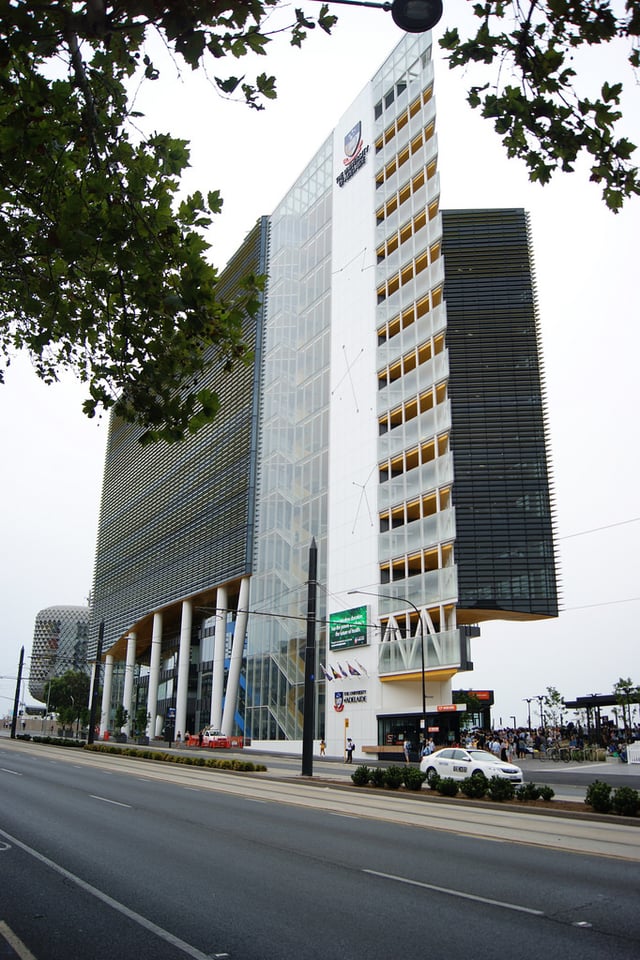
The University of Adelaide Health and Medical Sciences Building

The South Australian Health and Medical Research Institute (SAHMRI) located on North Terrace
Adelaide's two largest hospitals are the Royal Adelaide Hospital (RAH) in the city centre, a teaching hospital affiliated with the University of Adelaide (800 beds), and the Flinders Medical Centre (580 beds) in Bedford Park, affiliated with Flinders University. The RAH also operates additional campuses for specialist care throughout the suburbs including the Hampstead Rehabilitation Centre (150 beds) in Northfield and the Glenside Campus (129 beds) for acute mental health services. Other major public hospitals are the Women's and Children's Hospital (305 beds), in North Adelaide; the Queen Elizabeth Hospital (340 beds) in Woodville; Modbury Hospital (178 beds) in Modbury; and the Lyell McEwin Hospital (198 beds) in Elizabeth. Numerous private hospitals are also located throughout the city, with the largest operators being not-for-profits Adelaide Community Healthcare Alliance (3 hospitals) and Calvary Care (4 hospitals).
In 2017, the RAH was relocated from the city's East End to a new AU$2.3 billion facility built over former railyards in the West End.[153] The state-of-the-art hospital forms part of a new biomedical precinct called BioMed City that colocates the South Australian Health and Medical Research Institute (SAHMRI), the University of Adelaide Health and Medical Sciences building, the University of South Australia's Health Innovation Building, and the state's Dental Hospital.[154][155] SAHMRI is building a $300 million second facility due to be completed by 2022 to house the Australian Bragg Centre with Australia's first proton therapy unit.[156] There are also plans for the Women's and Children's Hospital to be relocated to the precinct adjacent the RAH by 2024.[157]
The largest provider of community health care within Adelaide is the not-for-profit Royal District Nursing Service (RDNS), which provides out of hospital care and hospital avoidance care.
Transport

A map of Adelaide's railway and tram network, served by the Adelaide Metro.
Being centrally located on the Australian mainland, Adelaide forms a strategic transport hub for east-west and north-south routes. The city itself has a metropolitan public transport system managed by and known as the Adelaide Metro. The Adelaide Metro consists of a contracted bus system including the O-Bahn Busway, 6 commuter rail lines (diesel and electric), and a small tram network operating between inner suburb Hindmarsh, the city centre, and seaside Glenelg. Tramways were largely dismantled in the 1950s, but saw a revival in the 2010s with upgrades and extensions. A proposal to significantly extend the tram network called AdeLINK is dormant following a change of state government.[158]
Road transport in Adelaide has historically been easier than many of the other Australian cities, with a well-defined city layout and wide multiple-lane roads from the beginning of its development. Adelaide was known as a "twenty-minute city", with commuters having been able to travel from metropolitan outskirts to the city proper in roughly twenty minutes. However, such arterial roads often experience traffic congestion as the city grows.[159]
The Adelaide metropolitan area has one freeway and three expressways. In order of construction, they are:
The South Eastern Freeway (M1), connects the south-east corner of the Adelaide Plain to the Adelaide Hills and beyond to Murray Bridge and Tailem Bend, where it then continues as National Highway 1 south-east to Melbourne.
The Southern Expressway (M2), connecting the outer southern suburbs with the inner southern suburbs and the city centre. It duplicates the route of South Road.
The North-South Motorway (M2), is an ongoing major project that will become the major north-south corridor, replacing most of what is now South Road, connecting the Southern Expressway and the Northern Expressway via an expressway with no traffic lights. Currently, the motorway runs as an elevated freeway from its junction with the Port River Expressway to Regency Road, in Adelaide's inner north-west. Continuation of the motorway is currently under construction in form of the Northern Connector project, the Darlington Upgrade project and the Torrens Road to River Torrens project.
The Port River Expressway (A9), connects Port Adelaide and Outer Harbor to Port Wakefield Road at the northern "entrance" to the metropolitan area.
The Northern Expressway (Max Fatchen Expressway) (M20), is the northern suburbs bypass route connecting the Sturt Highway (National Highway 20) via the Gawler Bypass to Port Wakefield Road at a point a few kilometres north of the Port River Expressway connection.
The Northern Connector (proposed route M20) commenced construction in 2016, to connect the North-South Motorway with the Northern Expressway. The road will not be subject to direct tolls, but South Australia will become a testing ground for a "network fee" that involves charging trucks based on road use and impact in place of high registration fees.
Airports
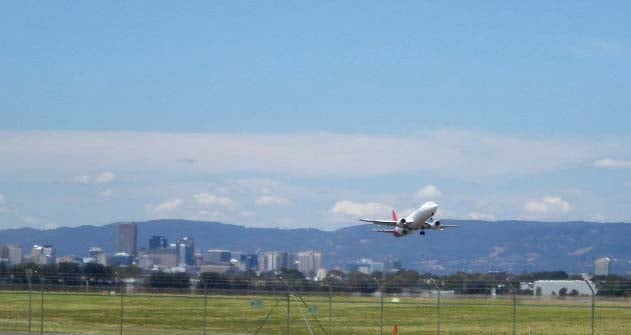
A Qantas plane leaving Adelaide Airport.
The Adelaide metropolitan area has two commercial airports, Adelaide International Airport and Parafield Airport. Adelaide Airport, in Adelaide's western suburbs, serves in excess of 8 million passengers annually.[160] Parafield Airport, Adelaide's second airport 18 kilometres (11 miles) north of the city centre, is used for small aircraft, pilot training and recreational aviation purposes. Parafield Airport served as Adelaide's main aerodrome until the opening of the Adelaide Airport in February 1955. Adelaide airport serves many international destinations and domestic destinations including all state capitals.
Utilities
Energy
Adelaide's energy requirements were originally met by the Adelaide Electric Supply Company, which was nationalised by the Playford government in 1946,[161] becoming the Electricity Trust of South Australia (ETSA). Despite significant public opposition and the Labor party's anti-privatisation stance which left the Liberal party one vote short of the numbers needed to pass the legislation, ETSA was privatised by the Olsen Government in 1999 by way of a 200-year lease for the distribution network (ETSA Utilities, later renamed SA Power Networks) and the outright purchase of ETSA Power by the Cheung Kong Holdings for $3.5 billion (11 times ETSA's annual earnings) after Labor MP Trevor Crothers resigned from the party and voted with the government.[162][163]
The electricity retail market was opened to competition in 2003 and although competition was expected to result in lower retail costs, prices increased by 23.7% in the market's first year.[164] In 2004 the privatisation was deemed to be a failure with consumers paying 60% more for their power and with the state government estimated to lose $3 billion in power generation net income in the first ten years of privatisation.[165] In 2012, the industry came under scrutiny for allegedly reducing supply by shutting down generators during periods of peak demand to force prices up. Increased media attention also revealed that in 2009 the state government had approved a 46% increase in retail prices to cover expected increases in the costs of generation while generation costs had in fact fallen 35% by 2012. South Australia has the highest retail price for electricity in the country.[166]
Privatisation led to competition from a variety of companies who now separately provide for the generation, transmission, distribution and retail sales of gas and electricity. Electricity generation comes from a range of technologies and operators. ElectraNet operates the high-voltage electricity transmission network. SA Power Networks distributes electricity to end users. The largest electricity and gas retailing companies are also the largest generating companies.
The largest fossil fuel power stations are the Torrens Island Power Station gas-fired plant operated by AGL Energy and the Pelican Point Power Station operated by Engie. South Australia also has wind and solar power and connections to the national grid. Gas is supplied from the Moomba Gas Processing Plant in the Cooper Basin via the Moomba Adelaide Pipeline System[167] and the SEAGas pipeline from Victoria.
In 2011, South Australia generated 18% of its electricity from wind power, and had 51% of the installed capacity of wind generators in Australia.[168]
Due to almost universal blackouts within the city during September 2016,[169] the state worked with Tesla to produce the world's largest electricity battery at Hornsdale Power Reserve which has increased that state's electrical security to the extent in which large blackouts are no longer an event.[170]
Water
The provision of water services is by the government-owned SA Water. Adelaide's water is supplied from its seven reservoirs: Mount Bold, Happy Valley, Myponga, Millbrook, Hope Valley, Little Para and South Para. The yield from these reservoir catchments can be as little as 10% of the city's requirements (90GL per annum[171]) in drought years and about 60% in average years. The remaining demand is met by the pumping of water from the River Murray.[171]
A sea-water desalination plant capable of supplying 100GL per annum was built during the 2001–2009 drought; however, it operated at about 8% of its capacity until 2019. In December 2018, the State and Federal Governments agreed to fund a $2m study to determine how the plant could be used to reduce reliance on river water, in an effort to help save the Murray River basin and mouth (including the Coorong) from further ecological damage.[171]
See also
Adelaide city centre includes chart of major streets and squares, street widths, and town acres
Adelaide Hills
City of Adelaide
Music of Adelaide
Port Adelaide
- Lists
Images of Adelaide
List of Adelaide obsolete suburb names
List of Adelaide parks and gardens
List of Adelaide railway stations
List of Adelaide suburbs
List of films shot in Adelaide
List of people from Adelaide
List of protected areas in Adelaide
List of public art in South Australia
List of public transport routes in Adelaide
List of South Australian commercial icons
List of sporting clubs in Adelaide
List of tallest buildings in Adelaide
Sister cities of the City of Adelaide (the Local government area that governs the city centre)
Tourist attractions in South Australia
